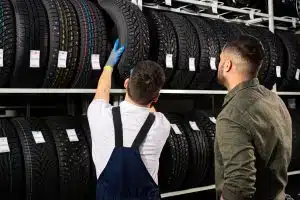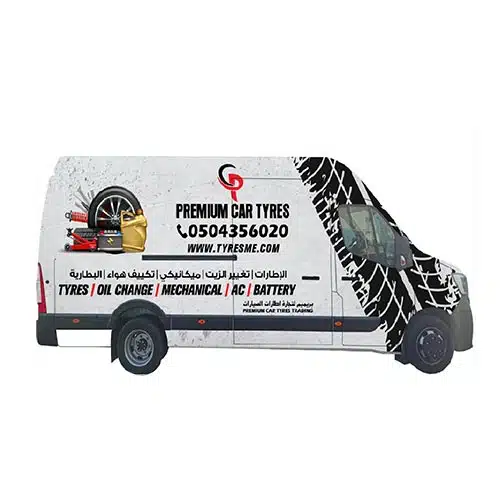Every driver needs new tires at some point, but figuring out the right time to make that purchase can be tricky. This tire buying guide will help you understand when to get new tires and what to look for in a tire buying guide, ensuring you drive safely and comfortably.
If you wish, you can buy tires online in Dubai through our website. Also, if you need free and specialized advice about buying the right tires for yourself, you can contact us.
All the top tire brands available that you can buy:
- BRIDGESTONE tire dubai
- PIRELLI tire dubai
- nexen tire dubai
- kumho tire dubai
- goodyear tire dubai
- cooper tire dubai
- continental tire dubai
Knowing When It’s Time to Change Your Tires
Tires are like shoes for your car; just as worn-out shoes can cause slips and falls, old tires can lead to dangerous driving situations. Knowing when it’s time to replace your tires is crucial for safe driving.
Signs Your Tires Need Replacing
Firstly, if you see any cracks or cuts on the surface or sides of your tires, it’s a clear sign that they need to be checked and possibly replaced. Another indicator is the tread depth in your car tire selection guide. The tread is the part of the tire that touches the road, and over time, it wears down. A simple way to check the tread depth in your car tire selection guide is with the penny test. Insert a penny into the tread with Lincoln’s head facing down; if you can see the top of his head, your tires are too worn and need replacing. Also, if you notice that your car is slipping more when it rains or if the ride doesn’t feel as smooth as it used to, these could be signs that your tires, as advised in the car tire selection guide, are worn out.
Understanding Tread Life and Tire Wear
Tire life varies depending on the type of car you drive, how you drive it, and the tire’s design. For instance, tires on a sports car driven aggressively might not last as long as tires on a family sedan driven gently. Tire manufacturers provide a tread life rating, an estimate of how long the tire should last under normal conditions. However, this is just a guideline; real-life factors like road conditions, weather, and driving habits can shorten this life expectancy. Regularly checking your tires, not just for tread depth but for any damage or irregular wear, is vital. Uneven wear can indicate problems with your car’s alignment or suspension, which can affect tire longevity and vehicle safety.
You can submit your request by filling out the form below. Our Service Consultant will contact you ASAP.
The Importance of Changing Your Tires
Changing the tires on your vehicle might seem like just another task to check off your maintenance list, but it plays a critical role in your safety and your vehicle’s overall performance. Just like you need good shoes to run faster and safer, your car needs good tires to perform at its best and keep you safe on the road.
Safety First: The Risks of Old Tires
Old tires can be downright dangerous. As tires age, they lose their grip, making it harder to stop quickly or steer clearly, especially in bad weather. Imagine running in old, worn-out sneakers on a slippery road; you’d likely struggle to keep your balance and might even fall. Similarly, old tires can cause your car to slide uncontrollably, increasing the risk of accidents. Worn tires also have a higher chance of blowing out while you’re driving, which could lead to a scary and unsafe situation on a busy road. By keeping your tires fresh, you’re not just protecting your car; you’re protecting yourself, your passengers, and other drivers.
Enhancing Your Vehicle’s Performance
Aside from safety, new tires can significantly enhance your vehicle’s performance, making understanding how to choose tires for car. Think of how a new pair of sneakers can make you run faster and jump higher. Similarly, selecting the right tires can improve your car’s acceleration, handling, and braking. The right tires can grip the road better, which means you can navigate corners more smoothly and stop more quickly when necessary. Moreover, good tires can even help your car use fuel more efficiently, saving you money at the gas pump. In snowy or rainy conditions, choosing the correct tires for your car can cut through water and slush, keeping your car stable and making your ride smoother and less stressful.
If you wish, you can also use our car battery sales and replacement services. For more information and services, visit Battery Replacement in Dubai.
How to Properly Change Your Tires
Changing your tires is a vital part of car maintenance that ensures your safety and the vehicle’s optimum performance. Whether you’re swapping out old tires for new ones or changing a flat on the side of the road, knowing how to properly change your tires is essential knowledge for every driver. Let’s dive into how you can safely replace your tires and the pros and cons of doing it yourself versus hiring a professional.
Steps to Safely Replace Your Tires
Expanding the text to include a detailed list with explanations for each item involved in changing a tire:
- Right Tools: To successfully change a tire, you need specific tools. These include:
– Jack: Used to lift the car off the ground so you can remove the tire.
– Lug Wrench: Needed to loosen and tighten the lug nuts that hold the tire to the wheel.
– Spare Tire: A replacement tire to install in place of the flat or damaged one.
- Flat, Stable Surface: Always ensure your car is parked on a surface that is flat and stable. This is crucial for safety and to prevent the car from moving while you are working on it.
- Parking Brake: Engaging the parking brake helps to ensure that the car remains stationary during the tire change process, providing an extra layer of safety.
- Loosen Lug Nuts: Before lifting the car, it’s important to loosen the lug nuts on the tire that is being replaced. This should be done while the tire is still on the ground to prevent the wheel from spinning.
- Lifting the Car: Use the jack to lift the car until the tire you are changing is completely off the ground. It’s important to place the jack under the correct part of the car’s frame or designated jack points to avoid damage.
- Removing the Tire: Once the car is lifted and stable, remove the loosened lug nuts completely, and then take off the tire.
- Installing the New Tire: Place the new or spare tire onto the wheel base, aligning it with the lug nut posts.
- Hand-Tighten Lug Nuts: Hand-tighten the lug nuts onto the posts to secure the tire in place before lowering the car back down. This helps to ensure that the tire is properly aligned.
- Lower the Car and Tighten Lug Nuts: Lower the car back to the ground using the jack. Once the car is fully lowered, use the lug wrench to tighten the lug nuts with the wrench in a criss-cross pattern. This method of tightening ensures that the pressure is evenly distributed across the tire, which is crucial for the safety and longevity of the tire.
Following these steps carefully will ensure that you can safely and effectively change a tire, minimizing the risk of any accidents or issues while on the road.
Choosing a Professional vs. DIY Tire Change
While changing a tire is a skill every driver should know, deciding whether to change your tires yourself or to have them changed by a professional depends on several factors. DIY tire changes are more than just a way to save money; they’re a chance to get hands-on experience with your vehicle’s maintenance. However, changing tires yourself requires time, physical effort, and the right tools. On the other hand, professionals have the equipment and expertise to get the job done quickly and safely. They can also provide valuable services such as balancing and aligning the new tires, which are crucial for maintaining your vehicle’s performance and extending tire life. If you’re not confident in your ability to change the tires safely or if you don’t have the proper tools, it’s wise to opt for professional tire change services.
If needed, you can use our mobile van services anywhere in Dubai. For more information, visit Car Repair in Dubai.
How to choose the best tires for your car?
When it comes to selecting new tires for your vehicle, the array of options can be overwhelming. Yet, making the right choice is crucial for your safety, comfort, and the car’s performance. It’s not just about finding a tire; it’s about finding the perfect fit for your driving habits, climate, and vehicle. Let’s navigate through the types of tires available and what factors you should consider, including tire ratings and reviews, to make an informed decision.
Types of Tires: All-Season, Performance, and Winter Tires
- All-Season Tires:
– Description: These tires are designed as the jack-of-all-trades, meant to perform well in a wide range of conditions, including rain and light snow.
– Best For: Drivers in moderate climates seeking a balance between performance and durability without the need for seasonal tire changes.
- Performance Tires:
– Description: Built for speed and agility, performance tires offer enhanced grip and handling on both wet and dry roads.
– Best For: Sports car enthusiasts or anyone desiring a more dynamic driving experience, prioritizing responsiveness and traction.
- Winter Tires:
– Description: Engineered with a special rubber compound that remains flexible in cold temperatures to provide superior traction in snow and ice.
– Best For: Those living in colder climates where snow and ice are common, ensuring safety and stability in adverse winter conditions.
Each tire type offers unique strengths, and the optimal choice for a driver depends on their vehicle specifications and the typical driving conditions they encounter.
What to Look for in a Tire: Ratings and Reviews
Beyond choosing the type of tire, there are several factors to consider to ensure you get the best performance and value, making understanding how to choose the best tires for your car essential. Tire ratings and reviews are invaluable resources as they provide insight into how a tire performs in real-world conditions. Look for ratings on tread life, which indicate how long you can expect the tire to last before it needs replacing. Also, pay attention to ratings on traction, which assess how well the tire grips the road, especially in wet conditions. Temperature ratings are another important factor, showing how well the tire can withstand heat, which is crucial for maintaining tire integrity and safety at high speeds.
Reviews from other drivers can also offer a wealth of information about a tire’s performance, noise level, and comfort when selecting the best tires for your car. They can highlight potential issues or advantages that aren’t always apparent in manufacturer descriptions or testing results. However, when reading reviews on how to choose the best tires for your car, consider the source and try to find feedback from drivers with similar vehicles and driving conditions to yours.
If your car needs an oil change, you can go to an oil change service in Dubai.
Understanding Tire Sizes and Specifications
Choosing the right tires for your vehicle involves understanding a bit about tire sizes and specifications. This knowledge not only ensures compatibility with your vehicle but also enhances its performance and safety. The information you need can typically be found on the tire’s sidewall, a series of letters and numbers that may seem like a secret code at first glance. Let’s break down what these markings mean and how you can ensure the tires you select are a perfect match for your vehicle.
Deciphering Tire Sidewall Information
The sidewall of a tire is filled with important information that tells you everything you need to know about its size, type, and performance capabilities. For example, you might see a marking like “P215/65R15 95H.” Let’s decode this: The “P” stands for passenger tire, indicating it’s designed for passenger vehicles. “215” represents the width of the tire in millimeters from one sidewall to another. The “65” is the aspect ratio, showing the height of the tire’s sidewall as a percentage of its width; a lower number means a shorter sidewall. The “R” indicates it’s a radial tire, which is the standard design for most tires today. “15” tells us the diameter of the wheel in inches that the tire is designed to fit. Finally, “95H” is the load index and speed rating; “95” tells us how much weight the tire can support, and “H” indicates the maximum speed the tire is rated for under full load.
Understanding these numbers and letters is crucial when shopping for new tires, as they ensure you select tires that fit your vehicle’s wheels and are suitable for its weight and speed capabilities.
How to Match Tires to Your Vehicle
To match tires to your vehicle properly, start by checking your vehicle’s owner manual or the placard on the driver’s side door jamb, which lists the recommended tire size and specifications. Using the sidewall code as a guide, ensure that any new tires you consider have the same diameter, load index, and speed rating as the manufacturer’s recommendations.
It’s also wise to consider how you use your vehicle. If you drive in a variety of weather conditions, all-season tires might be the best option. For drivers in regions with heavy snowfall, however, it could be beneficial to switch between all-season and winter tires as the seasons change.
When buying tires, it’s important not to mix and match different sizes and types on your vehicle. This can lead to handling problems and may even damage your vehicle. Always replace tires in pairs or complete sets to maintain the balance and stability of your ride.
If your car’s air conditioner has a problem; You can use our air conditioner repair in Dubai.
Why TyresMe Collection is the Best Choice
Choosing the right tires for your vehicle is a decision that can significantly impact your safety, comfort, and driving experience. With so many options available, it’s important to select a tire provider that not only offers a wide range of quality products but also understands your specific needs. That’s where TyresMe Collection stands out. Let’s explore the unique benefits of choosing us for your tire needs and share some stories from satisfied customers who have experienced the TyresMe difference firsthand.
The Advantages of Buying from Us
At TyresMe Collection, we pride ourselves on offering an unparalleled selection of tires for every type of vehicle and driving condition. Whether you’re looking for all-season tires that provide reliable performance year-round, ultra-high-performance tires for superior handling and speed, or durable all-terrain tires for your off-road adventures, we have you covered. Our expert team carefully selects each tire model based on rigorous testing and evaluation, ensuring that every product meets our high standards for quality, durability, and safety.
But our commitment to excellence goes beyond our product selection. We understand that buying tires can be overwhelming, which is why we offer personalized customer service to help you find the perfect tires for your vehicle and driving habits. Our knowledgeable staff is always ready to answer your questions, provide recommendations, and guide you through the buying process with ease. Plus, with competitive pricing and exclusive deals, you can enjoy the best value without compromising on quality.
Navigating Tire Warranties and Guarantees
Understanding the ins and outs of tire warranties and guarantees can save you time, money, and stress. When you purchase a new set of tires, knowing what warranty coverage includes and how to claim it is essential. Let’s delve into what is typically covered under a tire warranty and provide a clear, step-by-step guide on how to claim a warranty if the need arises.
What’s Covered: Understanding Your Tire Warranty
Most new tires come with some form of warranty protection, but it’s important to know exactly what is covered. Typically, tire warranties are categorized into a few types: tread life warranty, workmanship and materials warranty, and road hazard warranty. The tread life warranty assures you that the tires will last a certain number of miles. If they don’t, you may be eligible for a pro-rata replacement. The workmanship and materials warranty covers defects in the tire that are a result of the manufacturing process. Lastly, the road hazard warranty covers unexpected damages caused by potholes, nails, and other road debris.
It’s crucial to read the warranty document carefully, as it will specify what is covered and any conditions that might void the warranty. For example, warranties might not cover tires that have been used inappropriately, such as off-road tires used on highways or passenger car tires used on trucks.
If you’re in need of advice on selecting the right tires for your vehicle or you’re ready to make a purchase, don’t hesitate to contact the experts at Tyres me. Our team is dedicated to helping you find the perfect match for your car, ensuring safety, durability, and performance. Whether you have questions about tread patterns, tire sizes, or warranty claims, Tyres me experts are here to provide you with professional guidance and support. Reach out today to enhance your driving experience with the ideal set of tires.
FAQ
When should I replace my tires?
– Replace your tires if you notice cracks or cuts on the surface or sides, if the tread depth is too low (use the penny test where if you can see the top of Lincoln’s head, it’s time for a change), or if your car starts slipping more in wet conditions or feels less smooth than before.
How long can I expect my tires to last?
– Tire life expectancy varies by vehicle type, driving habits, and tire design. Manufacturers provide a tread life rating as a guideline, but real-world factors like road conditions and weather can affect this. Regular checks for damage and wear are essential.
What are the risks of driving on old tires?
– Old tires can lose grip, increasing the risk of accidents, especially in poor weather conditions. They are also more likely to blow out, creating dangerous situations on the road.
How can new tires improve my vehicle’s performance?
– New tires can significantly improve acceleration, handling, braking, and fuel efficiency. They provide better road grip, allowing for smoother navigation and quicker stops.
How do I properly change my tires?
– To change a tire, you’ll need a jack, a lug wrench, and a spare tire. Park on a flat surface, use the parking brake, loosen the lug nuts before lifting the car, then replace the tire, ensuring the lug nuts are tightened evenly in a criss-cross pattern.
Should I change my tires myself or hire a professional?
– Deciding between DIY and professional tire changes depends on your comfort level, physical ability, and access to tools. Professionals can ensure the job is done quickly and safely, including tire balancing and alignment.
How do I choose the right tire for my vehicle?
– Consider your driving habits, climate, and vehicle requirements. Look at tire ratings and reviews for tread life, traction, and temperature resistance, and make sure the tires match your vehicle’s size and performance specifications.
What does the information on my tire’s sidewall mean?
– The sidewall contains codes indicating the tire’s type, width, aspect ratio, construction, wheel diameter, and load and speed ratings. This information helps ensure compatibility and performance standards are met.






